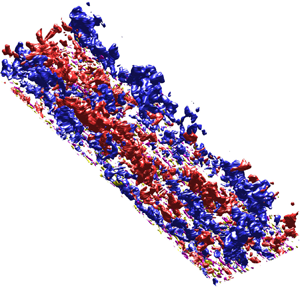Article contents
Interscale transport mechanisms in turbulent boundary layers
Published online by Cambridge University Press: 28 June 2021
Abstract

The flow physics of turbulent boundary layers is investigated using spectral analysis based on the spanwise scale decomposition of the Reynolds stress transport equation, with data obtained from a direct numerical simulation of the turbulent boundary layer at  $Re_\tau \simeq 2020$. Here, we extend the framework of Kawata & Alfredsson (Phys. Rev. Lett., vol. 120, 2018, p. 244501) for plane Couette flows to zero-pressure-gradient boundary layers. The equation contains three fundamental fluxes, which govern the Reynolds stress transport: (i) a scale flux of the interaction between small-scale and large-scale structures, and two spatial fluxes dominated by (ii) pressure and (iii) turbulent transport along the wall-normal direction. The scale flux reveals evidence of the inverse turbulent kinetic energy transfer, from small to large scales, occurring at the near-wall region, whereby for the scale flux of the Reynolds shear stress transport, the inverse transfer extends across the entire boundary layer. The wall-normal fluxes reveal the interactions occurring between scales at the buffer and logarithmic regions. In addition, there is interaction between the large-scale structures and the free stream flow occurring at the edge of the boundary layer, which was not observed in the Couette flow. Flow structures associated with inverse interscale transport of Reynolds shear stress are identified by applying conditional analysis to the spectrally decomposed velocity fields. While the inverse transport is interpreted as the net energy transfer from small-scale ejections (
$Re_\tau \simeq 2020$. Here, we extend the framework of Kawata & Alfredsson (Phys. Rev. Lett., vol. 120, 2018, p. 244501) for plane Couette flows to zero-pressure-gradient boundary layers. The equation contains three fundamental fluxes, which govern the Reynolds stress transport: (i) a scale flux of the interaction between small-scale and large-scale structures, and two spatial fluxes dominated by (ii) pressure and (iii) turbulent transport along the wall-normal direction. The scale flux reveals evidence of the inverse turbulent kinetic energy transfer, from small to large scales, occurring at the near-wall region, whereby for the scale flux of the Reynolds shear stress transport, the inverse transfer extends across the entire boundary layer. The wall-normal fluxes reveal the interactions occurring between scales at the buffer and logarithmic regions. In addition, there is interaction between the large-scale structures and the free stream flow occurring at the edge of the boundary layer, which was not observed in the Couette flow. Flow structures associated with inverse interscale transport of Reynolds shear stress are identified by applying conditional analysis to the spectrally decomposed velocity fields. While the inverse transport is interpreted as the net energy transfer from small-scale ejections ( $Q2$) and sweeps (
$Q2$) and sweeps ( $Q4$) to the large-scale counterparts, conditional time estimates of the direct and inverse interscale transport reveal that both processes play a substantial role across a broad range of scales.
$Q4$) to the large-scale counterparts, conditional time estimates of the direct and inverse interscale transport reveal that both processes play a substantial role across a broad range of scales.
JFM classification
Information
- Type
- JFM Papers
- Information
- Copyright
- © The Author(s), 2021. Published by Cambridge University Press
References
REFERENCES
- 29
- Cited by


